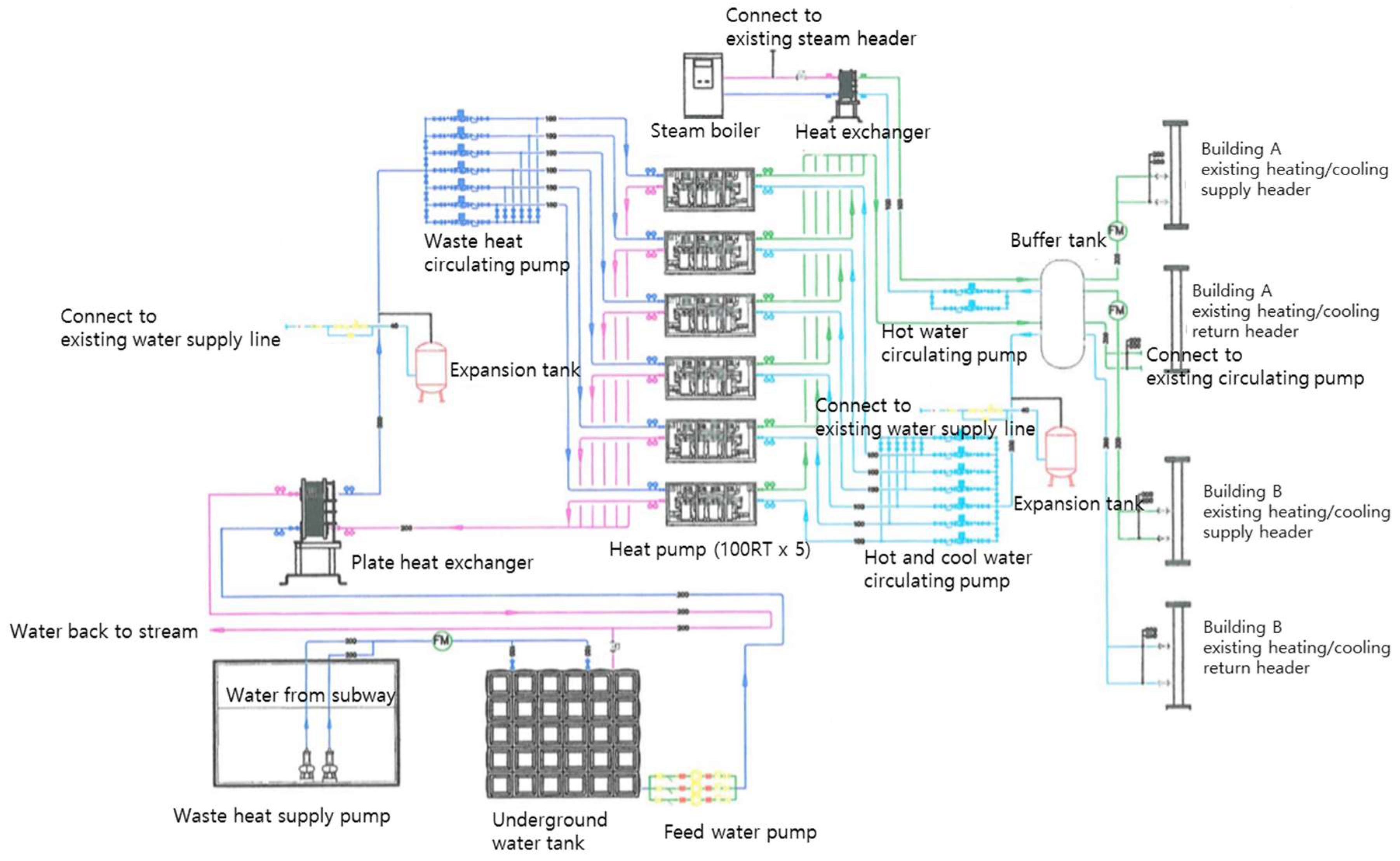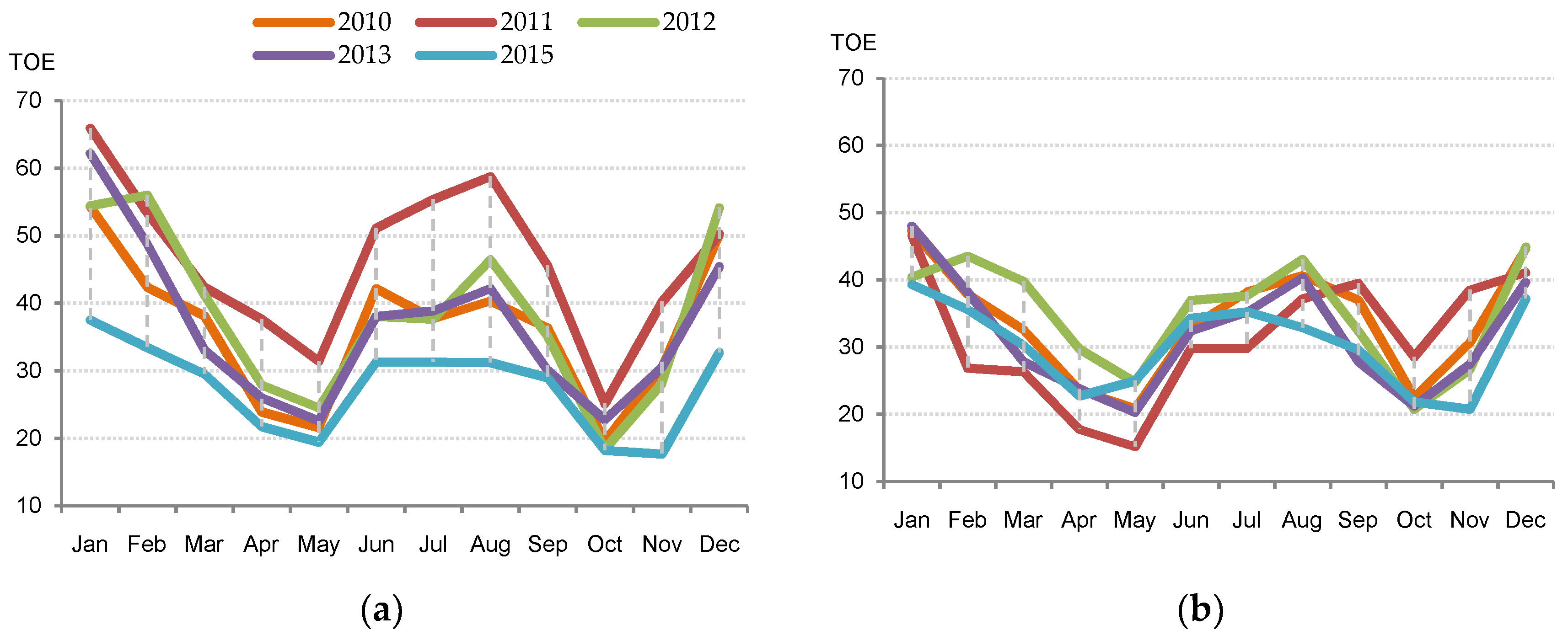Utilising Unused Energy Resources for Sustainable Heating and Cooling System in Buildings: A Case Study of Geothermal Energy and Water Sources in a University
Abstract
:1. Introduction
2. Related Studies
3. Research Methods
4. A Case Study of Geothermal Energy and Water Sources in a University
4.1. Building Characteristics
4.2. The Heating and Cooling System
4.3. Energy Consumption before and after Replacing the Heating and Cooling System
5. Conclusions
Author Contributions
Funding
Conflicts of Interest
References
- Sharifi, A.; Yamagata, Y. Principles and criteria for assessing urban energy resilience: A literature review. Renew. Sustain. Energy Rev. 2016, 60, 1654–1677. [Google Scholar] [CrossRef]
- Carley, S.; Baldwin, E.; MacLean, L.M.; Brass, J.N. Global Expansion of Renewable Energy Generation: An Analysis of Policy Instruments. Environ. Resour. Econ. 2016, 68, 397–440. [Google Scholar] [CrossRef]
- Korea Institute of Energy Research (KIER). Development for High Performance Heat Pump System Using River Water as Heat Source; Ministry of Science and Technology: Sejong-Si, Korea, 2004.
- Lee, Y.-H.; Shin, H.-J.; Yoon, H.-C.; Park, H.-G. Heating and Cooling System using the Sewage Source Absorption Refrigeration and Heat Pump Cycle. J. Korean Solar Energy Soc. 2007, 27, 19–26. [Google Scholar]
- Samyang Eco-Energy Co., Ltd. The Study of the Development of Air-Conditioning Technology Using Effluent Ground Water; Ministry of Commerce, Industry and Energy: Sejong-Si, Korea, 2007.
- Audit Committee. Evaluating Energy Policies; Seoul Metropolitan Government: Seoul, Korea, 2016.
- Il-Hwan, P.; Hyung-Kee, Y.; Jun-Taek, P.; Ki-Chang, C.; Young-Soo, L. A Study on the Potential Energy Reserve Amount of Domestic River Water as Unutilized Energy Resource. Korean J. Air-Cond. Refrig. Eng. 2005, 17, 521–528. [Google Scholar]
- Milenic, D.; Vasiljevic, P.; Vranjes, A. Criteria for use of groundwater as renewable energy source in geothermal heat pump systems for building heating/cooling purposes. Energy Build. 2010, 42, 649–657. [Google Scholar] [CrossRef]
- Nam, Y.; Ooka, R. Numerical simulation of ground heat and water transfer for groundwater heat pump system based on real-scale experiment. Energy Build. 2010, 42, 69–75. [Google Scholar] [CrossRef]
- Cho, Y.; Yun, R. A raw water source heat pump air-conditioning system. Energy Build. 2011, 43, 3068–3073. [Google Scholar] [CrossRef]
- Park, C.-S.; Park, K.-W.; Kwon, O.-K. Performance Characteristics and Economic Assessment of Heat Pump System with the Various Heat Source. Trans. Korea Soc. Geotherm. Energy Eng. 2011, 7, 23–31. [Google Scholar]
- Chen, C.; Sun, F.-L.; Feng, L.; Liu, M. Underground water-source loop heat-pump air-conditioning system applied in a residential building in Beijing. Appl. Energy 2005, 82, 331–344. [Google Scholar] [CrossRef]
- Bae, H.H.; Lee, D.H.; Lee, S.; Kim, B.; Ahn, Y.C. A Study on the Performance Improvement of a Simultaneous Heating and Cooling Water Source Heat Pump System by Controlling of the Refrigerant Flow Rate in an Outdoor Unit. Korean J. Air-Cond. Refrig. Eng. 2013, 25, 131–136. [Google Scholar] [CrossRef] [Green Version]
- Luo, J.; Rohn, J.; Bayer, M.; Priess, A.; Wilkmann, L.; Xiang, W. Heating and cooling performance analysis of a ground source heat pump system in Southern Germany. Geothermics 2015, 53, 57–66. [Google Scholar] [CrossRef]
- Zhu, N.; Hu, P.; Wang, W.; Yu, J.; Lei, F. Performance analysis of ground water-source heat pump system with improved control strategies for building retrofit. Renew. Energy 2015, 80, 324–330. [Google Scholar] [CrossRef]
- Zhao, H.-X.; Magoulès, F. A review on the prediction of building energy consumption. Renew. Sustain. Energy Rev. 2012, 16, 3586–3592. [Google Scholar] [CrossRef]
- Park, K.S.; Kim, S. The relationship between energy consumption and factors affecting heating and cooling. Archit. Res. 2017, 19, 7–11. [Google Scholar] [CrossRef]
- Airaksinen, M. Energy Use in Day Care Centers and Schools. Energies 2011, 4, 998–1009. [Google Scholar] [CrossRef] [Green Version]
- Abdelalim, A.; O’Brien, W.; Shi, Z. Visualization of energy and water consumption and GHG emissions: A case study of a Canadian University Campus. Energy Build. 2015, 109, 334–352. [Google Scholar] [CrossRef]
- Agdas, D.; Srinivasan, R.S.; Frost, K.; Mastersd, F.J. Energy use assessment of educational buildings: Toward a campus-wide sustainable energy policy. Sustain. Cities Soc. 2015, 17, 15–21. [Google Scholar] [CrossRef]
- Dirks, J.A.; Gorrissen, W.J.; Hathaway, J.H.; Skorski, D.C.; Scott, M.J.; Pulsipher, T.C.; Huang, M.; Liu, Y.; Rice, J.S. Impacts of climate change on energy consumption and peak demand in buildings: A detailed regional approach. Energy 2015, 79, 20–32. [Google Scholar] [CrossRef] [Green Version]
- Park, K.S.; Kim, M.J. Energy Demand Reduction in the Residential Building Sector: A Case Study of Korea. Energies 2017, 10, 1506. [Google Scholar] [CrossRef]




| Location | Direction | Building Type | Year Built | Total Floor Area | Materials | System Operation | |
|---|---|---|---|---|---|---|---|
| Building A | Humanities campus, Korea university | SE | Academic | Early 2000s | ~14,390 m2 | Reinforced concrete structure, granite, double-glazed windows | Central heating and cooling |
| Building B |
| Area | Daily Peak Load | Monthly Peak Load | |
|---|---|---|---|
| Building A | Cooling | 63.74 | 56.63 |
| Heating | 56.81 | 43.96 | |
| Building B | Cooling | 103.82 | 94.18 |
| Heating | 123.52 | 104.15 | |
© 2018 by the authors. Licensee MDPI, Basel, Switzerland. This article is an open access article distributed under the terms and conditions of the Creative Commons Attribution (CC BY) license (http://creativecommons.org/licenses/by/4.0/).
Share and Cite
Park, K.S.; Kim, S. Utilising Unused Energy Resources for Sustainable Heating and Cooling System in Buildings: A Case Study of Geothermal Energy and Water Sources in a University. Energies 2018, 11, 1836. https://doi.org/10.3390/en11071836
Park KS, Kim S. Utilising Unused Energy Resources for Sustainable Heating and Cooling System in Buildings: A Case Study of Geothermal Energy and Water Sources in a University. Energies. 2018; 11(7):1836. https://doi.org/10.3390/en11071836
Chicago/Turabian StylePark, Kwon Sook, and Seiyong Kim. 2018. "Utilising Unused Energy Resources for Sustainable Heating and Cooling System in Buildings: A Case Study of Geothermal Energy and Water Sources in a University" Energies 11, no. 7: 1836. https://doi.org/10.3390/en11071836





